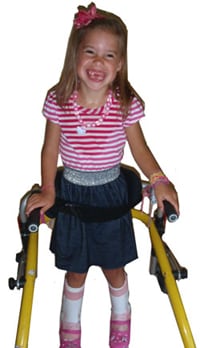Causes and Risk Factors of Cerebral Palsy

Cerebral palsy (CP) is caused by abnormal development of the brain or damage to the developing brain that affects a child’s ability to control his or her muscles. There are several possible causes of the abnormal development or damage. People used to think that CP was mainly caused by lack of oxygen during the birth process. Now, scientists think that this causes only a small number of CP cases.
The abnormal development of the brain or damage that leads to CP can happen before birth, during birth, within a month after birth, or during the first years of a child’s life, while the brain is still developing.
Congenital CP
CP related to abnormal development of the brain or damage that happened before or during birth is called congenital CP. The majority of CP (85%–90%) is congenital. In many cases, the specific cause is not known.
Risk Factors for Congenital CP
Some things increase the chance that a child will have CP. These are called risk factors. It is important to remember that having a risk factor does not mean that a child will have CP. Some of the risk factors for congenital CP are:
- Low birthweight―Children who weigh less than 5 1/2 pounds (2,500 grams) at birth, and especially those who weigh less than 3 pounds, 5 ounces (1,500 grams) have a greater chance of having CP. Read article
- Premature birth―Children who were born before the 37th week of pregnancy, especially if they were born before the 32nd week of pregnancy, have a greater chance of having CP. Intensive care for premature infants has improved a lot over the past several decades. Babies born very early are more likely to live now, but many have medical problems that can put them at risk for CP. Read article
- Multiple births―Twins, triplets, and other multiple births have a higher risk for CP, especially if a baby’s twin or triplet dies before birth or shortly after birth. Some, but not all of this increased risk is due to the fact that children born from multiple pregnancies often are born early or with low birthweight, or both. Read summary
- Assisted reproductive technology (ART) infertility treatments―Children born from pregnancies resulting from the use of some infertility treatments have a greater chance of having CP. Most of the increased risk is explained by preterm delivery or multiple births, or both; both preterm delivery and multiple births are increased among children conceived with ART infertility treatments. Read article, Read summary
- Infections during pregnancy―Infections can lead to increases in certain proteins called cytokines that circulate in the brain and blood of the baby during pregnancy. Cytokines cause inflammation, which can lead to brain damage in the baby. Fever in the mother during pregnancy or delivery also can cause this problem. Some types of infection that have been linked with CP include viruses such as chickenpox, rubella (german measles), and cytomegalovirus (CMV), and bacterial infections such as infections of the placenta or fetal membranes, or maternal pelvic infections. Read summary, Read article
- Jaundice and kernicterus― Jaundice is the yellow color seen in the skin of many newborns. Jaundice happens when a chemical called bilirubin builds up in the baby’s blood. When too much bilirubin builds up in a new baby’s body, the skin and whites of the eyes might look yellow. This yellow coloring is called jaundice. When severe jaundice goes untreated for too long, it can cause a condition called kernicterus. This can cause CP and other conditions. Sometimes, kernicterus results from ABO or Rh blood type difference between the mother and baby. This causes the red blood cells in the baby to break down too fast, resulting in severe jaundice.
- Medical conditions of the mother―Mothers with thyroid problems, intellectual disability, or seizures have a slightly higher risk of having a child with CP. Read summary
- Birth complications―Detachment of the placenta, uterine rupture, or problems with the umbilical cord during birth can disrupt oxygen supply to the baby and result in CP. Read summary

Preventing CP
In many cases, the cause or causes of congenital CP aren’t fully known, which means that currently little can be done to prevent it. CP related to genetics is not preventable. However, there are actions people can take before and during pregnancy, as well as after birth that might help reduce the risk of developmental problems, including CP.
Taking steps to help ensure a healthy pregnancy can help prevent developmental problems, including CP. Acquired CP often is related to an infection or injury, and some of these cases can be prevented.
Before Pregnancy
- Be as healthy as possible before pregnancy. Make sure that any infections in the mother are treated and health conditions are in control, ideally before pregnancy occurs.
- Get vaccinated for certain diseases (such as chickenpox and rubella) that could harm a developing baby. It is important to have many of these vaccinations before becoming pregnant.
- If assistive reproductive technology (ART) infertility treatments are used to get pregnant, consider ways to reduce the chance of a multiple pregnancy (twins, triplets, or more), such as transferring only one embryo at a time.

During Pregnancy
- Learn how to have a healthy pregnancy.
- Get early and regular prenatal care, both for your health and for that of your developing baby.
- Wash your hands often with soap and water to help reduce the risk of infections that might harm your developing baby.
- Contact your health care provider if you get sick, have a fever, or have other signs of infection during pregnancy.
- A flu shot is your best protection against serious illness from the flu. A flu shot can protect pregnant women and their unborn babies, both before and after birth. Flu shots have not been shown to cause harm to pregnant women or their babies.
- If there is a difference in the blood type or Rh incompatibility between mother and baby it can cause Jaundice and kernicterus. Women should know their blood type and talk to their doctor about ways to prevent problems. Doctors can treat the mother with Rh immune globulin (“Rhogam”) when she is 28 weeks pregnant and again shortly after giving birth to prevent kernicterus from occurring.
- Talk to your doctor about ways to prevent problems if you are at risk for preterm delivery. Research has shown that taking magnesium sulfate before anticipated early preterm birth reduces the risk of CP among surviving infants. (1,2,3,4)
After the Baby is Born
- Learn how to help keep your baby healthy and safe after birth.
- Any baby can get jaundice. Severe jaundice that is not treated can cause brain damage, called kernicterus. Kernicterus is a cause of CP that potentially can be prevented. Your baby should be checked for jaundice in the hospital and again within 48 hours after leaving the hospital. Ask your doctor or nurse about a jaundice bilirubin test. In addition, steps can be taken to prevent kernicterus that is caused by Rh blood type incompatibility between the mother and baby.
- Make sure your child is vaccinated against infections that can cause meningitis and encephalitis, including Haemophilus influenzae type B (HiB vaccine) and Streptococcus pneumoniae (pneumococcal vaccine).
- Take steps to prevent injuries:
- Buckle your child in the car using an infant or child car seat, booster seat, or seat belt (according to the child’s height, weight, and age).
- Make living areas safer for children by using window guards to keep young children from falling out of open windows and using safety gates at the top and bottom of stairs.
- Make sure the surface on your child’s playground is made of a shock-absorbing material, such as hardwood mulch or sand.
- Carefully watch young children at all times around bathtubs, swimming or wading pools, and natural bodies of water. Adults watching kids near water should avoid distracting activities like using a computer or handheld device, reading, or talking on the phone.
- Make sure your child wears a helmet for activities like riding a bike.
- Never hit, throw, shake, or hurt a child.
For More Information
- Doyle LW, Crowther CA, Middleton P, Marret S. Antenatal magnesium sulfate and neurologic outcome in preterm infants: a systematic review. Obstet Gynecol. 2009 Jun;113(6):1327-33.
- Magnesium sulfate before anticipated preterm birth for neuroprotection. Committee Opinion No. 455. American College of Obstetricians and Gynecologists. Obstet Gynecol 2010;115:669–71.
- Crowther CA, Middleton PF, Voysey M, et al (2017). Assessing the neuroprotective benefits for babies of antenatal magnesium sulphate: An individual participant meta-analysis. PLoS Med, 14(10):e1002398.
- Magnesium sulfate use in obstetrics. Committee Opinion No. 652. American College of Obstetricians and Gynecologists. Obstet Gynecol 2016;127(1):e52-3.